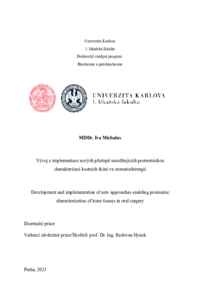Vývoj a implementace nových přístupů umožňujících proteomickou charakterizaci kostních tkání ve stomatochirurgii
Development and implementation of new approaches for proteomic characterization of bone tissues in oral surgery
dissertation thesis (DEFENDED)

View/
Permanent link
http://hdl.handle.net/20.500.11956/187448Identifiers
Study Information System: 218706
Collections
- Kvalifikační práce [4870]
Author
Advisor
Referee
Šebela, Marek
Hrabal, Richard
Faculty / Institute
First Faculty of Medicine
Discipline
Biochemistry and Pathobiochemistry
Department
external workplaces
Date of defense
30. 11. 2023
Publisher
Univerzita Karlova, 1. lékařská fakultaLanguage
Czech
Grade
Pass
Keywords (Czech)
stomatochirurgie, maxilární kosti, mandibulární kosti, proteomická analýza, přímé specifické štěpení proteinů, tandemová hmotnostní spektrometrie s předřazenou kapalinovou chromatografiíKeywords (English)
oral surgery, maxillary bones, mandibular bones, proteomic analysis, direct specific cleavage of proteins, tandem mass spectrometry coupled with liquid chromatography1 Abstrakt Proteomika je bouřlivě se rozvíjející obor, který nachází uplatnění v mnoha oblastech medicíny, včetně stomatologie. Přesto proteomická charakterizace kostních tkání ve stomatochirurgii není stále běžně využívána. Hlavní příčinou je značná komplikovanost používaných analytických přístupů, která vyplývá z nerozpustného charakteru kostních tkání. Cílem této práce bylo vyvinout a aplikovat přímočarou metodiku, která by mohla vést k rutinnímu využití proteomiky i v této oblasti. Nejprve byla s využitím prasečích čelistních kostí jako modelových vzorků vyvinuta technika umožňující identifikovat až stovky proteinů díky jejich štěpení trypsinem přímo v kostních tkáních ("in-bone digestion") následovaného analýzou pomocí tandemové hmotnostní spektrometrie s předřazenou kapalinovou chromatografií (LC-MS/MS). Tato technika byla následně aplikována na analýzu odoperovaných tkání lidských maxilárních a mandibulárních kostních tkání. Jak ve vzorcích maxilárních, tak mandibulárních kostí, bylo možné technikou přímého štěpení identifikovat značné množství proteinů. Navíc matematická analýza získaných dat umožnila též rozlišit mezi tkáněmi postiženými zánětem a zdravými tkáněmi. Přístup založený na přímém štěpení byl následně úspěšně rozšířen též na analýzu in vitro modelů lidských kostních tkání. Přímé štěpení...
1 Abstract Proteomics is a booming field with application in many areas of medicine, including dentistry. Nevertheless, proteomic characterization of bone tissues in oral surgery is not still commonly used. The main reason is involvement of demanding analytical approaches due to insoluble chatacter of bone tissues. The goal of this work was to develop and apply straightforward methodology that could lead to the routine use of proteomics in this area as well. Using porcine jawbones as a model samples, a technique was developed allowing identifying about hundreds of proteins thanks to their trypsin digestion directly in bone tissues ("in-bone digestion") followed by analysis using liquid chromatography coupled with tandem mass spectrometry (LC-MS/MS). This technique was subsequently applied to the analysis of human maxillary and mandibular bone tissues obtained during surgical procedures. In both maxillary and mandibular bone samples, it was possible to identify a considerable amount of proteins using the "in-bone digestion" technique. Additionaly, the mathematical analysis of the obtained data was able to distinguish between the inflammatory and healthy tissues. The approach based on direct cleavage was subsequently successfully extended to the analysis of in vitro models of human bone tissues. Direct...
